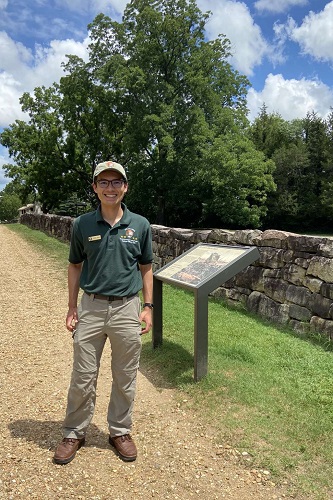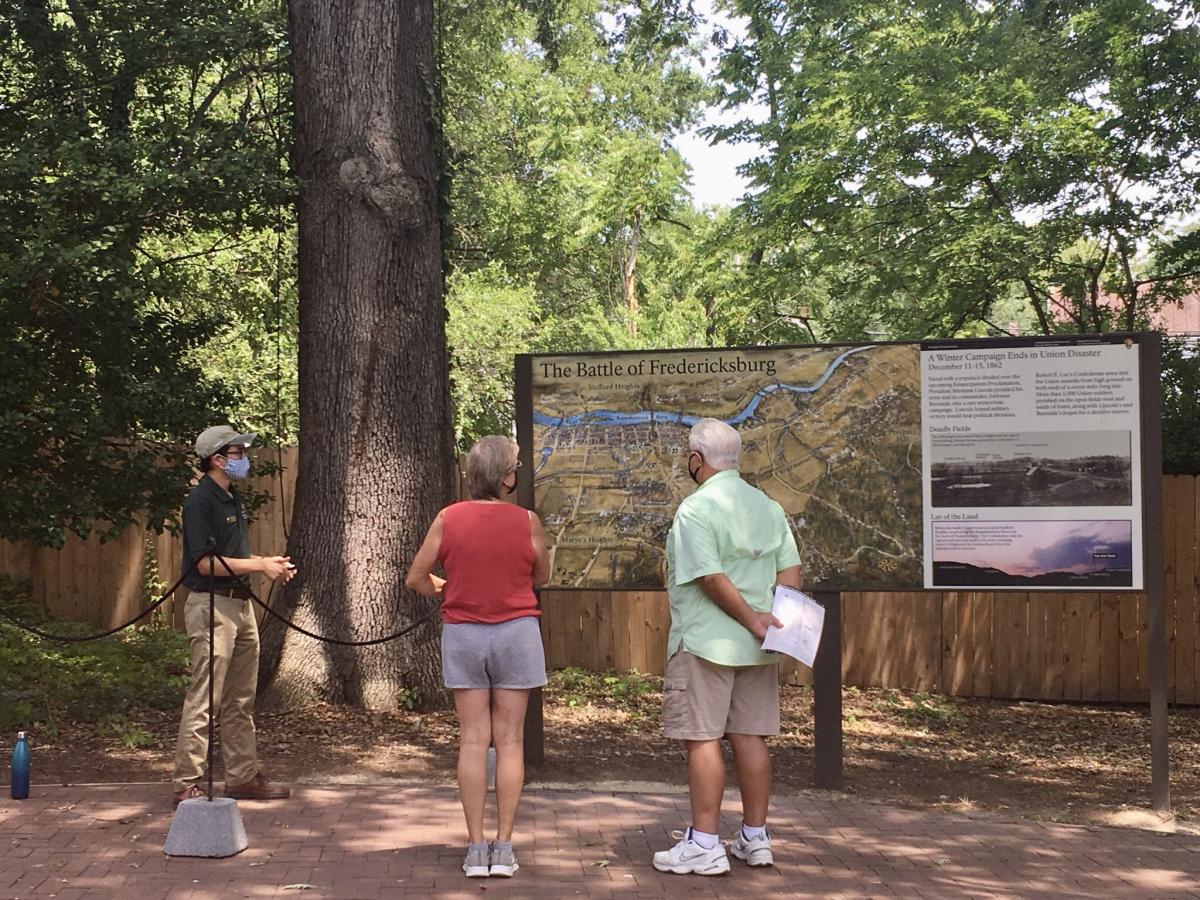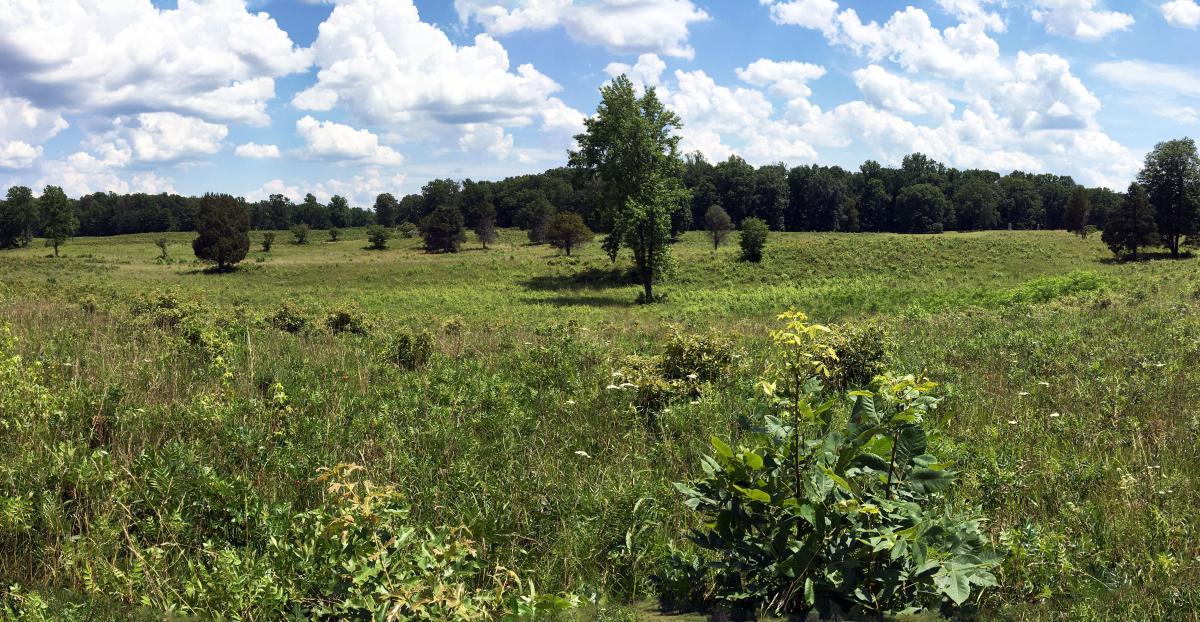Reflections from Fredericksburg: Stephen Artner on His Summer 2020 Internship
by Stephen Artner | | Monday, August 24, 2020 - 11:24

By all accounts this summer has been nothing short of the strangest in recent memory. Yet, I would submit, no other time could have been more apt than the current moment to work on the front lines engaging with the public at a Civil War park. I spent two months of this summer working for Fredericksburg & Spotsylvania National Military Park (hereafter FRSP). Providing historical interpretation on Civil War battlefields amidst a global pandemic and a national reckoning about our shared history certainly posed challenges, but it also proved immensely fruitful for generating deep thought and productive dialogue with visitors and colleagues alike. Unlike a normal summer, I could not sit in the comfort of a visitor center and allow the museum exhibits and movie to do most of the interpreting for me, since all public buildings were closed and all staff worked outside. Nor could I rest content merely sharing details of troop movements and leaders with the public, since the challenging questions posed by visitors and staff forced me to think long and hard on questions of Civil War memory and memorialization, among a host of other important issues. Working for the park during this unparalleled summer forced me to become a much broader historical thinker, a more engaged conversationalist, and a better interpreter than I ever could have been otherwise.
My internship with FRSP began at the start of June with a week of online training and then almost two weeks of full-day battlefield tours and on-site training. I was lucky enough to be assigned three primary “duty stations” for the summer: the Sunken Road at Fredericksburg, Saunders Field at the Wilderness, and the Bloody Angle at Spotsylvania Court House. This park is unique in that it encompasses four battlefields as well as three major historic structures within its boundaries. Yet despite the park’s immensity it manages to tell a coherent and vivid narrative, eighteen months long from beginning to end. The Army of the Potomac and the Army of Northern Virginia seemed to gravitate inexorably to these killing fields again and again between 1862 and 1864, etching the names of previously unknown landmarks such as Marye’s Heights and Brock Road and the Rapidan River indelibly into American history. The gravity of interpreting what happened on this land impressed itself upon me distinctly, especially since I was posted on three separate battlefields. One day I would be telling the story of Burnside and the pontoon crossing at Fredericksburg, and the next I would be attempting to narrate the ghastly melee of the Mule Shoe at Spotsylvania. The breadth of time I needed to cover – from the immediate aftermath of Antietam to the middle of the Overland Campaign – forced me to take a wider gaze on the Civil War than I would have if I had only been working at one site.
Since public health restrictions barred our ability to give formal walking tours and work from inside visitor centers, we had to adapt. Each day would feature between two to six staff members setting up outside and engaging with visitors in an informal manner. We would give orientation to casual recreationists and historical context to those with a deeper interest in the battles. We also fielded a wide range of questions from visitors, answering the best we could with what knowledge we had. At times we would give 15- to 30-minute presentations by the large battle map at each site. This constituted the closest thing to formal interpretation we did, but even then our presentations were often free-flowing and tailored more specifically to the individual groups of two to ten that we were presenting to.

Thanks to the foresight of our supervisors we were limited to no more than five hours outdoors in the heat every day. The rest of the workday was allocated as “project time” for us to spend indoors doing reading, research, or a formal project for the park. I used my project time for the first half of the summer to get a real familiarity with the sites and stories I was to interpret. I also used the time to read widely on topics I felt not yet confident enough in to discuss with visitors: the mindset of secession commissioners regarding slavery and the root cause of the Civil War (Charles B. Dew, Apostles of Disunion); the vast sweep of changing Civil War memory (Caroline E. Janney, Remembering the Civil War); and the core tenets of the “Southern interpretation” of the Civil War (Gary W. Gallagher and Alan T. Nolan, The Myth of the Lost Cause). It was a blessing to have time designated by the park to read these books and others, for I felt that the insights I gleaned from them made me much more articulate, confident, and calm when dialoguing with visitors on controversial topics. In my last few weeks I used my project time to film and edit professional videos for the park website featuring our permanent rangers discussing themes like the USCT troops during the Overland Campaign, the different nuances regarding Civil War monuments, and the fight over Saunders Field in the Wilderness. My hope is that they will be a resource for homebound “virtual visitors” to experience the knowledge our stellar rangers have to offer as well as to stimulate thought and discussion on difficult issues relating to the Civil War.
This summer saw its fair share of visitors to the park with an axe to grind. The majority of them were characterized by sentiments stemming from the “Lost Cause,” an interpretation of the Civil War that justified secession as constitutional and downplayed the role of slavery in both Southern society and in the cause of the Civil War. Oftentimes these visitors would loudly lament the fact that monuments to Confederate icons such as Lee and Jackson have been coming down across America. A few went so far as to justify slavery as a positive good. Our first instinct as interns was to get piping mad and to rear for a verbal fight with anyone espousing these unacceptable views. We had the facts all handy–the secession papers, the Cornerstone speech, the slave narratives. But oftentimes our attempts to argue with visitors fell on deaf ears. Our attempts at “converting” these visitors away from their ingrained Lost Cause mentality were far too overt, far too forced, to be of much use.
Eventually I realized over the course of the summer that we were going about this all wrong. Our primary task as park historians was to interpret and to teach, not to attack and convert. A true teaching experience never occurs when one or both parties are on the defensive. If a park intern or uniformed ranger gets into a verbal brawl with a visitor, both sides will only become more entrenched in their views. At the same time, we would be shirking our duty if we simply ignored or “let slide” what we know to be inaccurate claims. The goal, then, is to have real engagement with someone in the spirit of Socratic dialogue: swallowing one’s intellectual pride and oftentimes withholding one’s own opinions, taking a much more subtle question-asking approach that tries to develop nuance rather than win the argument. Proving one’s own correctness is antithetical to real dialogue.

The best interactions I witnessed were ones in which my site supervisor, Ranger Pete, would have completely calm conversations with “Lost Causers.” First he would scope out whether there was any possibility of real conversation, or whether the visitor was just there to spout. He would do this by quickly affirming any areas of agreement with the visitor (however small), and then very subtly introducing points of nuance. This would immediately change the conversation’s tone from combative to exploratory. If the visitor seemed receptive, Pete would add more things into the mix. He would never assert such-and-such as his own opinion, but often used phrases like “I’ve talked to lots of people who think about this differently than you, and this is what they say: . . .” This tactic almost always disarmed the angry visitor and presented Pete as an unbiased source of information rather than an equally angry proselyte trying to convert the visitor. Pete would often tell me that he never expected such visitors to have “eureka!” moments right in front of us in which they abandoned everything their grandfather told them about the Civil War–that would be too much to expect. But his hope was always that he may have planted a small seed in the visitor which, later that day or that week, would reassert itself and cause him or her to rethink some things even just a tiny bit. In my opinion, Pete’s philosophy was perhaps one of the most effective ways to create a teaching moment even in the face of vitriol and entrenched views. His goal was to engage in real conversations, not shouting matches. He hoped to effect a positive change in the visitor’s own heart, however small, rather than scoring argumentative “points.”
These two short months at FRSP have changed me immeasurably for the better. I’ve been able to indulge my love for Civil War history, bond with coworkers over shared experiences, expand my understanding of the war’s causes and consequences, talk to the public about these seminal events in our shared heritage, and become a more competent and articulate educator. The lessons I learned about adapting my message to each specific person and focusing on questions rather than argumentative points will stick with me for the rest of my life. I cannot thank the John L. Nau III Center for Civil War History and all the staff at FRSP enough for this incredible opportunity. I only wish I had many months more to spend in Fredericksburg doing what I love.
Stephen Artner is a fourth year undergraduate student at the University of Virginia studying literature and intellectual history. He was a Summer 2020 intern at Fredericksburg & Spotsylvania National Military Park, where he worked primarily in public historical interpretation.
